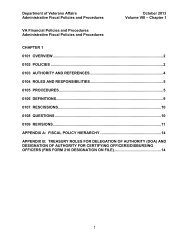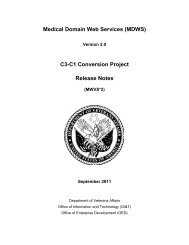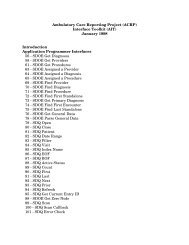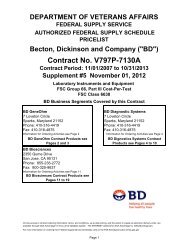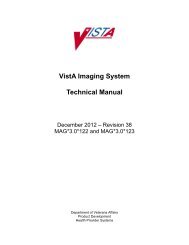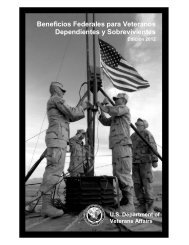a guidebook for veterans incarcerated in texas - US Department of ...
a guidebook for veterans incarcerated in texas - US Department of ...
a guidebook for veterans incarcerated in texas - US Department of ...
Create successful ePaper yourself
Turn your PDF publications into a flip-book with our unique Google optimized e-Paper software.
For example: Tom is rated as 80 percent disability (80% service connected).While <strong><strong>in</strong>carcerated</strong> he can only receive the amount he would get if he was 10percent disabled (10% service connected). However, his family may beapportioned up to 70 percent, the difference <strong>of</strong> the 80 percent rat<strong>in</strong>g. (80%service connected m<strong>in</strong>us 10% service connected = 70% service connected.The 70% goes to Tom’s family.)There is a 60-day “grace period” follow<strong>in</strong>g conviction where the Veteran ordependent family members (also called Dependency or IndemnityCompensation (DIC) recipients) may still receive full benefits. If the Veterancont<strong>in</strong>ues to receive benefits after the 60-day period, it will result <strong>in</strong> anoverpayment. The VA considers it to be the Veteran’s responsibility and faultif this occurs because the Veteran failed to notify the VA <strong>of</strong> his or her<strong>in</strong>carceration. Attempts to obta<strong>in</strong> a waiver <strong>in</strong> these situations <strong>of</strong> overpaymentare <strong>of</strong>ten unsuccessful. As a rule, the Veteran loses most, if not all, f<strong>in</strong>ancialbenefits until the VA recovers the entire overpayment. It has also been astandard procedure that the family will not be entitled to receive anapportionment until the debt is completely recovered.It is important to remember that most VA decisions, <strong>in</strong>clud<strong>in</strong>g those onapportionment, can be appealed to the Board <strong>of</strong> Veterans Appeals and, ifneed be, to the Court <strong>of</strong> Appeal <strong>for</strong> Veterans Affairs.RE-STARTING BENEFITS AT RELEASEThe VA Regional Office (VARO) needs <strong>for</strong>mal notification from the prison <strong>of</strong>your release <strong>in</strong> order to re-start benefits. This means you need to take yourrelease papers from prison to the VARO <strong>in</strong> person. The sooner thatdocumentation is provided to the VARO, the sooner the VARO can beg<strong>in</strong> toprocess your request. Your award <strong>for</strong> compensation or pension benefitsshould resume from the date you are released, as long as the VA receivesnotice <strong>of</strong> your release with<strong>in</strong> one year.Alternatively, you can complete Form 21-4193 (Notice to <strong>Department</strong> <strong>of</strong>Veterans Affairs <strong>of</strong> Veteran or Beneficiary Incarcerated <strong>in</strong> Penal Institution)be<strong>for</strong>e your release, have it signed by a prison <strong>of</strong>ficial and submitted to theVA Regional Office.SEEKING HELP AFTER RELEASEIf you would like to get benefits or th<strong>in</strong>k you have a pend<strong>in</strong>g claim be<strong>for</strong>e theVA, it is best to get pr<strong>of</strong>essional help to assist you. Many Veterans ServiceOrganizations (VSO’s) have tra<strong>in</strong>ed staff who can help you with your VA claimand can legally represent your claim be<strong>for</strong>e the VA. Some also help23





